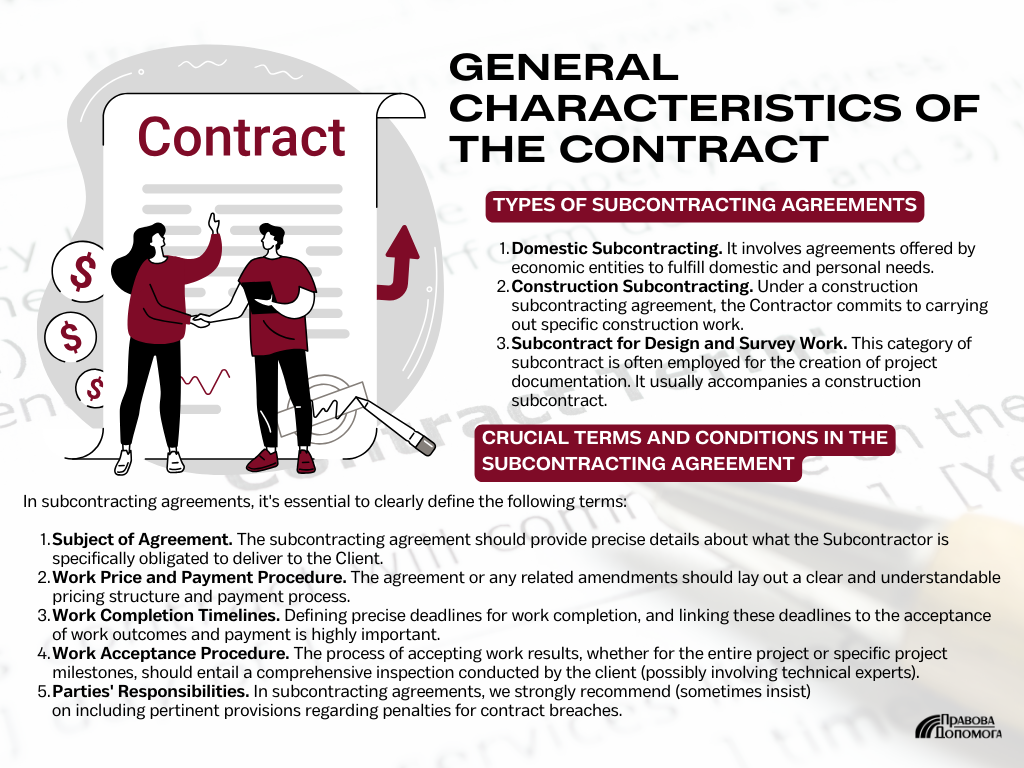General characteristics of the contract: everything about concluding an agreement
Cost of services:
Reviews of our Clients
... our work on joint projects assured us of your high level of professionalism
A subcontracting agreement is one of the most common types of contracts used in the business world, both in Ukraine and globally. The popularity of subcontracting agreements can be attributed to the simplicity of their concept: one party undertakes specific work and delivers the results to another party in exchange for compensation.
This type of transaction is often compared in terms of content to a service contract, likely because of the similarity in the contract's subject matter. However, these contracts are entirely distinct. Under a subcontracting agreement, specific tasks are performed, and results are handed over, while a service contract involves the provision of services that are either immediately consumed or carried out within the context of specific activities. For example, if you need to construct a house or produce a particular product using your resources, it is advisable to utilize a subcontracting agreement. Conversely, if you require legal assistance or IT services, it is preferable to enter into a service agreement.
Even legal professionals sometimes find it challenging to distinguish when to use a subcontracting agreement versus a service agreement. Consequently, in subcontracting contracts, especially those obtained from online sources, you may come across discrepancies in the terminology used to identify the parties. For instance, "Executor" might be substituted with "Contractor," or the specific legal requirements of Ukraine, which apply to subcontracting contracts, may be overlooked. It's important to note that, in practice, there can be hybrid agreements that blend elements from different types of contracts. Nonetheless, in all cases, it is crucial to accurately identify and properly execute the appropriate contract, a task for which our team of lawyers is readily available to assist you.
Key Legal Aspects and Specifics of Subcontracting Agreements
The legislation in foreign countries may not always provide specific details on subcontracting agreements. However, regarding legal matters within Ukraine, it's crucial to adhere to the legal requirements concerning subcontracting agreements. We have encountered a particularly illustrative case in our practice. A client approached us intending to construct a real estate project. This is, of course, a multifaceted process that involves acquiring licenses (declarations), various permits, and technical documentation. Our legal team was able to assist the client in an expedited manner.
At a certain stage in the construction process, there was a need to engage a specialized company to carry out specific tasks. This company initially suggested entering into a service agreement. However, upon a thorough examination of the document, we recommended pursuing a subcontracting agreement. We worked to define the project's stages, completion deadlines, the contractor's responsibilities, and the procedure for work acceptance. The result was a motivated subcontractor who executed their duties well and within the agreed-upon timeframes.
Types of Subcontracting Agreements
Ukrainian legislation provides specific classifications and details on the following types of subcontracting agreements:
1. Domestic Subcontracting. It involves agreements offered by economic entities to fulfill domestic and personal needs. It is considered a public arrangement, which means it establishes uniform terms and conditions for all customers. For instance, tasks like shoe repair or window installation fall within the realm of household subcontracting. These agreements can be established through a public offer, a formal contract, or by documenting the agreement through a receipt or another confirming document.
2. Construction Subcontracting. Under a construction subcontracting agreement, the Contractor commits to carrying out specific construction work. This can encompass activities like reconstruction, new construction, major renovations, or commissioning work, for which the Contractor is compensated.
A construction subcontract is a complex contractual arrangement that involves several crucial elements:
- Requirement for Appropriate Project Documentation: Depending on the specific project, the required documentation may vary. However, it is essential that the subcontractor strictly adheres to the provided documents, plans, and agreed-upon timelines.
- Preparation of Cost Estimates: Typically, construction projects necessitate the creation of detailed cost estimates, which involve determining labor, material costs, and other related expenses. Pricing can be established through a fixed price or an approximate price, as outlined in the contract.
- Necessity for Permits and Licenses: The subcontractor must obtain the necessary permits and licenses to perform specific tasks. For our clients, we facilitate the acquisition of permits for high-risk activities. In the case of businesses planning to engage in construction work, we assist in obtaining declarations, especially during times of war, to undertake construction work with consequence classes СС2 and СС3.
- Complex Contractual Structure: A construction subcontract is intricate and should comprehensively address and regulate numerous details.
- Involvement of Technical Specialists: Most construction subcontracts require the engagement of various technical specialists to ensure the project's success.
While this article does not delve deeply into the intricacies of construction subcontracts, it is worth noting that seeking legal advice is advisable when entering into such an agreement with a subcontractor. This is because the cost of making errors or not fully understanding the nuances of these transactions can be substantial.
3. Subcontract for Design and Survey Work. This category of subcontract is often employed for the creation of project documentation. It usually accompanies a construction subcontract. When agreeing to design and survey work, it is crucial to verify the subcontractor's expertise and confirm the possession of any necessary certifications, if required. It's essential to establish the terms and conditions. In our practical experience, we assisted a client in crafting a contract for the development of project documentation for a specific land parcel.
You may also like: Drafting Agreements: Key Considerations in Contract Law
Crucial Terms and Conditions in the Subcontracting Agreement
In subcontracting agreements, it's essential to clearly define the following terms:
1. Subject of Agreement. The subcontracting agreement should provide precise details about what the Subcontractor is specifically obligated to deliver to the Client. This means the contract should outline the types of work, expected outcomes, technical specifications (if relevant), and the extent of the subcontractor's responsibilities. Failure to do so can create challenges for the Client when seeking the desired results of the work. Since Clients often lack specialized knowledge, in some cases, it may be advisable to engage technical experts to assist in aligning the technical aspects of the subcontracting agreement.
2. Work Price and Payment Procedure. The agreement or any related amendments should lay out a clear and understandable pricing structure and payment process. Subcontracting agreements are often intricate, and payment is typically tied to the achievement of specific milestones. For example, as the subcontractor completes a preparatory phase for a construction project, they receive payment. As they progress through specific tasks, these are approved by the client, followed by payments, and so on. It is also essential to define which party is responsible for providing materials for the subcontract.
3. Work Completion Timelines. Defining precise deadlines for work completion, and linking these deadlines to the acceptance of work outcomes and payment is highly important. For instance, when hiring a company for a major renovation project, it's beneficial to establish a clear project completion date and arrange payment upon the actual fulfillment and acceptance of the work. In such cases, the client retains the ability to demand rectification of any defects and withhold payment for subpar work.
4. Work Acceptance Procedure. The process of accepting work results, whether for the entire project or specific project milestones, should entail a comprehensive inspection conducted by the client (possibly involving technical experts). The client should either approve the results or provide feedback and comments. It's crucial to realize that once work results are accepted and an acceptance document is signed, demonstrating subpar work quality becomes challenging. Therefore, two aspects are vital in this regard: having the correct work acceptance procedure stipulated in the contract and conducting a thorough examination of the results before formal acceptance.
5. Parties' Responsibilities. n subcontracting agreements, we strongly recommend (sometimes insist) on including pertinent provisions regarding penalties for contract breaches. Penalty clauses serve two primary purposes: firstly, they incentivize both parties to fulfill their obligations with quality and punctuality; secondly, they allow one party to seek compensation if they have suffered damages due to the actions or inactions of the other party.
We have provided just a few of the key terms that we highly recommend taking into account. However, depending on the type of subcontract and the complexity of the work, the contract may encompass additional provisions that are crucial for the parties involved.
Subcontracting agreements can be executed in a straightforward written format, and notarization is optional, according to the parties' preferences.
Amending and Terminating a Subcontract Agreement
We recommend a careful and thorough approach when it comes to entering into a subcontracting agreement. Making changes or terminating such a contract can be more challenging and costly. Changes or terminations of a subcontracting agreement can be made based on the following general principles:
- Mutual consent of the parties.
- A court decision.
- When specified in the agreement or required by law.
In addition, the Civil Code allows for the termination of a subcontracting agreement if the subcontractor has not commenced the work or if the work progresses so slowly that it violates the agreed-upon deadlines. The client can also terminate the subcontracting agreement at any time, but such termination usually involves compensating the subcontractor for the work completed and materials used (if specified in the agreement). Other grounds for terminating the agreement can be stipulated within the contract itself.
In most cases, terminating a subcontracting agreement involves a legal and claims procedure, where either the client may seek to receive work of the desired quality and compensation for any breaches, or the subcontractor may request payment for their work.
To minimize risks, our legal firm is fully equipped to provide services related to contract development, contract modifications, and dispute resolution for subcontracting agreements.
Our clients







